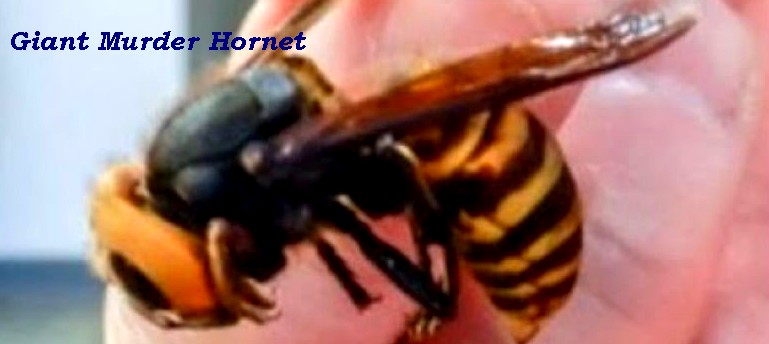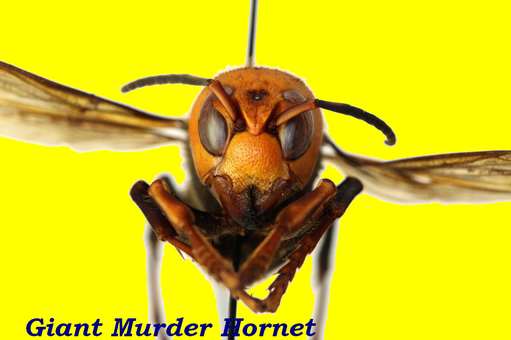

Ci mancava pure il Calabrone Gigante Asiatico, noto scientificamente come "Vespa mandarinia Smith."
E' capace di mettere a rischio la vita degli alveari e soprattutto quella dell'uomo.
E se arrivasse pure in Italia?
Il nostro Paese storicamente, per non aver attuato delle misure di prevenzione in anticipo,
si è spesso dovuto confrontare con diverse malattie provenienti dall'Asia, malattie che hanno
fortemente influenzato l'apicoltura, in particolare dal punto di vista economico, per le devastazioni
subite da diverse specie di insetti.
Basta ricordare, come è noto ormai a tutti gli apicoltori ed alla comunità scientifica internazionale,
il famoso acaro del genere Varroa, in origine parassita della specie asiatica nota come "apis cerana."
La prima segnalazione ufficiale di ritrovamento della varroa sull'ape europea , l'Apis mellifera ,
è avvenuta in Cina nel 1958.
Da lì si è diffusa in diversi Stati fino ad arrivare in America , negli Stati Uniti nel 1987,
e successivamente, in Italia, negli anni 80.
Oggi, dopo le tante devastazioni subite del passato, si è riusciti a controllare il fenomeno
con diversi trattamenti messi in atto dagli apicoltori.
Parlando di calabroni, il famoso calabrone asiatico ( vespa velutina) probabilmente
introdotto dalla Cina accidentalmente nel 2003, pare essere stato esportato tramite un carico
di bonsai proveniente dallo Yunnan.
Anche in questo caso si sono messe in atto delle misure di contrasto fino a creare delle zone rosse
per circoscrivere il suo raggio di diffusione.
Attualmente siamo obbligati a destinare importanti risorse finanziarie per far fronte alle diverse patologie provenienti
dall'Asia, e quindi siamo anche maggiorante penalizzati nella produzione sia del miele che della pappa reale.
Ricordiamo infatti che, mentre in Cina si produce più pappa reale che in altri paesi,
in Italia si fa fatica a rilanciare la produzione e si soffre proprio della concorrenza Cinese,
concorrenza ammessa fra le larghe maglie delle normative europee piuttosto favorevoli proprio ai prodotti Cinesi.
Oggi lo scenario si fa ancora più preoccupante con il noto calabrone asiatico (Vespa mandarinia Smith),
che in America in questi giorni ha creato uno stato di allerta per l'apicoltura e per rischi legati alla vita umana,
in quanto capace di uccidere con molta facilità anche gli esseri umani.
E se arrivasse in Italia ?
Cosa potremmo fare per difenderci ?
Cosa possiamo fare per salvare le nostre attività ?
Dovremmo istituire altrettante" zone rosse" per contenere
il diffondersi di questo insetto ?
Se è vero che in Italia non c'è stato una tempestiva azione del Governo nel far fronte al Covid 19, è
altrettanto vero che se non si prendono in anticipo delle misure di carattere preventivo
per contrastare il Gigante Asiatico, ci ritroveremo in una situazione analoga.
Non solo.
Tutti noi ci auspichiamo che il Calabrone killer non sia frutto di manipolazioni genetiche, come
è avvenuto per alcune specie di api che storicamente per errore umano sono diventate potenzialmente killer,
perché altrimenti la situazione si potrebbe complicare notevolmente.
Considerata la possibilità che la diffusione ad oggi è limitatissima, sarebbe opportuno già ora
ridurre qualsiasi importazione di beni che possano fungere da vettore di trasporto dell'insetto.
Questo accorgimento ci permetterebbe di rallentare il fenomeno e di avere il tempo per studiare gli eventuali
predatori ( rettili, uccelli,,,ect) che possano limitare la loro proliferazione,
creando delle zone di controllo del calabrone nelle sue principali aree di insediamento.
Già da ora sarebbe possibile attivare degli istituti di ricerca affinché si studino
sostanze chimiche che , selettivamente associate a delle esche create opportunamente
a base di carne ( data la loro natura carnivora) ,
lo sopprimano gradualmente dando la possibilità di trasmettere la sostanza dannosa all'interno
del nido causando la loro morte per "effetto a cascata"..
Altrettanto utile sarebbe lo studiare quelle sostanze chimicamente capaci di distruggerlo
velocemente per preservare la sua diffusione nelle zone semi-urbane ed urbane, sostanze da utilizzarsi
con tutte le relative misure di precauzione legate al trattamento dell'area nel caso di utilizzo
di una sostanza pericolosa .
Insomma anche preparasi fin d'ora a combattere contro il Calabrone Killer sarà una delle probabili
sfide per la nostra scienza.
Per maggiori informazioni:
mimmo.barracco80@gmail.com
( Dott. Girolamo Barracco)

Invasive “Murder Hornet” Reaches U.S., Deadly Pest Targets Honey Bees
Just when we thought it was safe to go outside… murder hornets?
New York
North America has long been plagued by invasive species that do not belong and that devastate the natural habitat
in certain areas.
From plants like Kudzu to Pythons in the Everglades, thousands of native species of plants
and animals are under threat.
And, now it appears as if honey bees have a new predator to contend with… the “murder hornet.”
These deadly, giant hornets claim about 50 lives in Japan every year, and the other devastations
they can cause could have serious repercussions.
DNYUZ reported:
In his decades of beekeeping, Ted McFall had never seen anything like it.
As he pulled his truck up to check on a group of hives near Custer, Wash., in November, he could spot
from the window a mess of bee carcasses on the ground.
As he looked closer, he saw a pile of dead members of the colony in front of a hive and more carnage
inside — thousands and thousands of bees with their heads torn from their bodies and no sign of a culprit.
“I couldn’t wrap my head around what could have done that,” Mr. McFall said.
Only later did he come to suspect that the killer was what some researchers simply call the “murder hornet.”
With queens that can grow to two inches long, Asian giant hornets can use mandibles shaped like spiked shark
fins to wipe out a honeybee hive in a matter of hours, decapitating the bees
and flying away with the thoraxes to feed their young.
For larger targets, the hornet’s potent venom and stinger — long enough to puncture a beekeeping suit — make for
an excruciating combination that victims have likened to hot metal driving into their skin.
In Japan, the hornets kill up to 50 people a year. Now, for the first time, they have arrived in the United States.
Mr. McFall still is not certain that Asian giant hornets were responsible for the plunder of his hive.
But two of the predatory insects were discovered last fall in the northwest corner of Washington State,
a few miles north of his property — the first sightings in the United States.
Scientists have since embarked on a full-scale hunt for the hornets, worried that the invaders
could decimate bee populations in the United States and establish such a deep presence that
all hope for eradication could be lost.
“This is our window to keep it from establishing,” said Chris Looney, an entomologist at the Washington State
Department of Agriculture.
“If we can’t do it in the next couple of years, it probably can’t be done.”
On a cold morning in early December, two and a half miles to the north of Mr. McFall’s property,
Jeff Kornelis stepped on his front porch with his terrier-mix dog.
He looked down to a jarring sight:
“It was the biggest hornet I’d ever seen.”
The insect was dead, and after inspecting it, Mr. Kornelis had a hunch that it might be an Asian giant hornet.
It did not make much sense, given his location in the world, but he had seen an episode of the YouTube personality
Coyote Peterson getting a brutal sting from one of the hornets.
Beyond its size, the hornet has a distinctive look, with a cartoonishly fierce face featuring teardrop eyes
like Spider-Man, orange and black stripes that extend down its body like a tiger, and broad, wispy wings like a
small dragonfly.
Mr. Kornelis contacted the state, which came out to confirm that it was indeed an Asian giant hornet.
Soon after, they learned that a local beekeeper in the area had also found one of the hornets.
Mr. Looney said it was immediately clear that the state faced a serious problem,
but with only two insects in hand and winter coming on, it was nearly impossible to determine how much the
hornet had already made itself at home.
Over the winter, state agriculture biologists and local beekeepers got to work, preparing for the coming season.
Ruthie Danielsen, a beekeeper who has helped organize her peers to combat the hornet,
unfurled a map across the hood of her vehicle, noting the places across Whatcom County where beekeepers have placed traps.
“Most people are scared to get stung by them,” Ms. Danielsen said.
“We’re scared that they are going to
totally destroy our hives.”
Adding to the uncertainty — and mystery — were some other discoveries of the Asian giant hornet across
the border in Canada.
In November, a single hornet was seen in White Rock, British Columbia, perhaps 10 miles away
from the discoveries in Washington State — likely too far for the hornets to be part of the same colony.
Even earlier, there had been a hive discovered on Vancouver Island, across a strait that probably was too
wide for a hornet to have crossed from the mainland.
Crews were able to track down the hive on Vancouver Island.
Conrad Bérubé, a beekeeper and entomologist in the town of Nanaimo, was assigned to exterminate it.
He set out at night, when the hornets would be in their nest.
He put on shorts and thick sweatpants, then his bee suit.
He donned Kevlar braces on his ankles and wrists.
But as he approached the hive, he said, the rustling of the brush and the shine of his flashlight awakened the colony.
Before he had a chance to douse the nest with carbon dioxide, he felt the first searing stabs in his
leg — through the bee suit and underlying sweatpants.
“It was like having red-hot thumbtacks being driven into my flesh,”
he said. He ended up getting stung at least seven times, some of the stings drawing blood.
Jun-ichi Takahashi, a researcher at Kyoto Sangyo University in Japan, said the species had earned the “murder hornet”
nickname there because its aggressive group attacks can expose victims to doses of toxic venom equivalent to that
of a venomous snake;
a series of stings can be fatal.
The night he got stung, Mr. Bérubé still managed to eliminate the nest and collect samples, but the next day,
his legs were aching, as if he had the flu.
Of the thousands of times he has been stung in his lifetime of work, he said, the Asian giant hornet stings
were the most painful.
After collecting the hornet in the Blaine area, state officials took off part of a leg and shipped it
to an expert in Japan.
A sample from the Nanaimo nest was sent as well.
A genetic examination, concluded over the past few weeks, determined that the nest in Nanaimo
and the hornet near Blaine were not connected, said Telissa Wilson, a state pest biologist, meaning there had
probably been at least two different introductions in the region.
Mr. Looney went out on a recent day in Blaine, carrying clear jugs that had been made into makeshift traps;
typical wasp and bee traps available for purchase have holes too small for the Asian giant hornet.
He filled some with orange juice mixed with rice wine, others had kefir mixed with water,
and a third batch was filled with some experimental lures — all with the hope of catching a queen emerging
to look for a place to build a nest.
He hung them from trees, geo-tagging each location with his phone.
In a region with extensive wooded habitats for hornets to establish homes, the task of finding
and eliminating them is daunting.
How to find dens that may be hidden underground?
And where to look, given that one of the queens can fly many miles a day,
at speeds of up to 20 miles per hour?
The miles of wooded landscapes and mild, wet climate of western Washington State make it an ideal location
for the hornets to spread.
In the coming months, Mr. Looney said, he and others plan to place hundreds more traps that could catch worker hornets
that would start becoming active over the summer.
State officials have mapped out the plan in a grid, starting in Blaine and moving outward.
The buzz of activity inside a nest of Asian giant hornets can keep the inside temperature up to 86 degrees,
so the trackers are also exploring using thermal imaging to examine the forest floors.
Later, they may also
try other advanced tools that could track the signature hum the hornets make in flight.
If a hornet does get caught in a trap, Mr. Looney said, there are plans to possibly use radio-frequency
identification tags to monitor where it goes — or simply attach a small streamer and then follow the horne
as it returns to its nest.
While most bees would be unable to fly with a disruptive marker attached, that is not the
case with the Asian giant hornet.
It is big enough to handle the extra load.
Link al video:
https://conservativedailypost.com/supreme-court-makes-history-first-time-ever-change-thanks-to-covid/
Courtesy by Georgette

SCRIVI: IL TUO COMMENTO

- Today' NEW contacts -